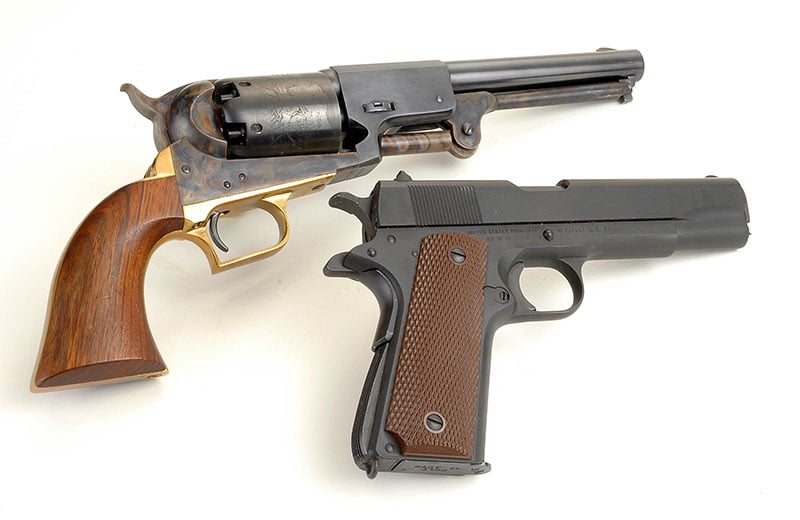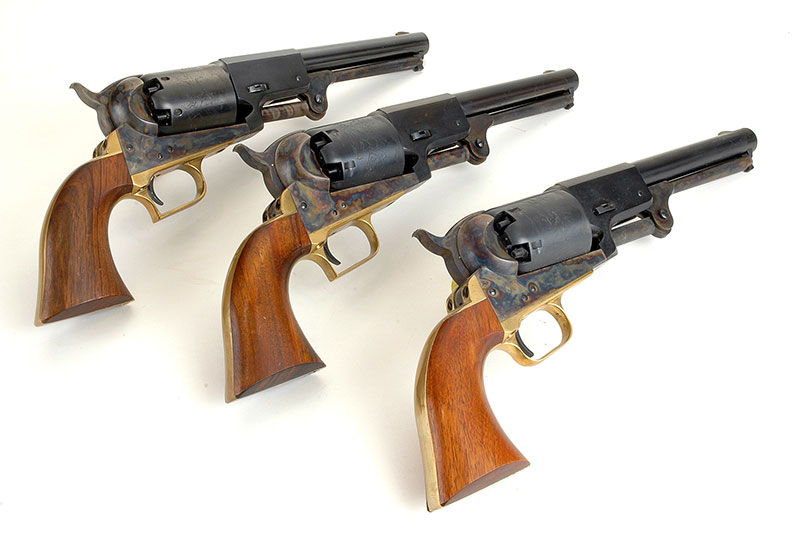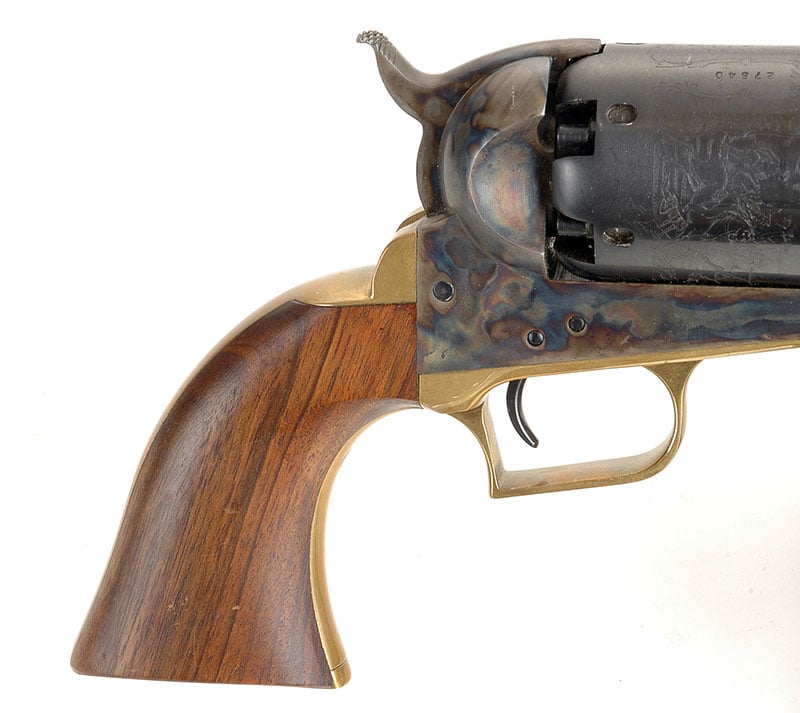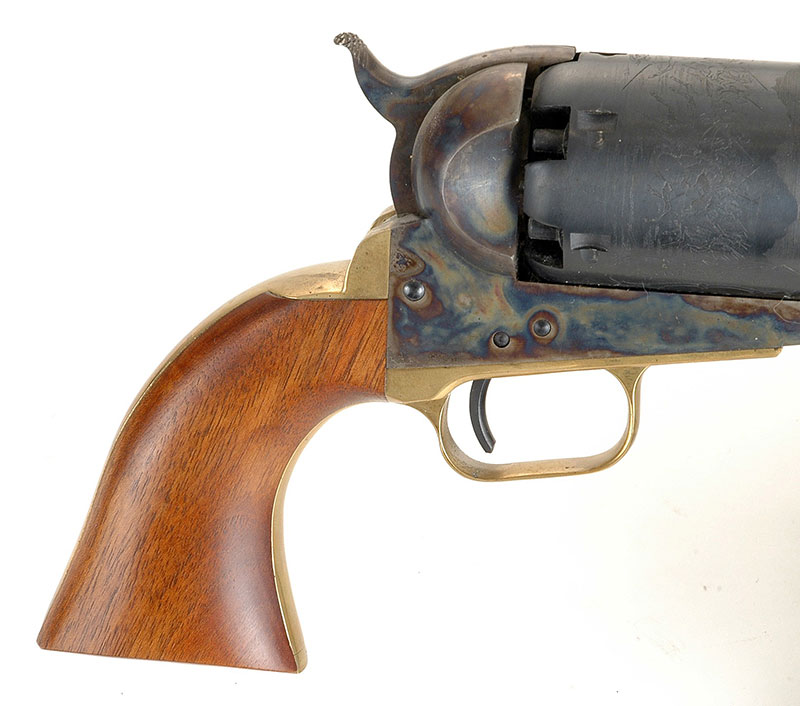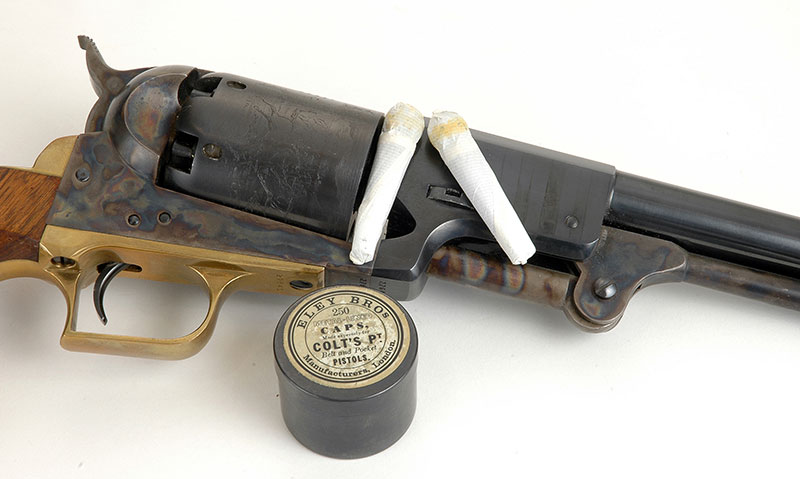The Dragoons
The Walker Design Refined
Part 2 of 12 Part Genesis of the Colt Single Action
As pointed out in Part One of this series, in U.S. Army parlance of the 1840s/1850s the word Dragoon referred to horse mounted troops. It’s also the term modern collectors applied to the next series of improvements Samuel Colt made on his revolving handguns after the Walker version of 1847.
Without a doubt the Colt/Walker was just too much of a good thing. It was too long, too heavy and too powerful. Therefore in 1848 Samuel Colt reduced barrel length to 7½” and cylinder length was shortened from the 1 9/16″ of the Walker to 1 7/1″. That meant powder capacity was now about 50 grains instead of 60 grains. Caliber was retained at .44, however.
Perhaps the most significant change pertained to function. With the three versions of Dragoon revolvers Samuel Colt began putting a latch at the end of the rammer so it stayed-put during shooting. At this point a word about the sight arrangement of Colt’s big .44s is in order. Judging from the sights, fighting with a handgun in those days most certainly was a young man’s realm. Older gents couldn’t even see such sights as Samuel Colt felt appropriate for handguns. The Walker and all three Dragoon versions shared the same sight arrangement. Front sight was a tiny blade silver soldered into a small groove milled in the barrel. Rear sight was a likewise tiny notch cut into the hammer nose. There was no provision for adjusting point of impact in regards to point of aim.
Another thought regarding point of aim with Colt Walker and Dragoon sights is that evidently they were meant to hit “on” for elevation at about 100 yards. Let’s face matters as they were. These handguns were intended for shooting people and doctrine called for them to be aimed “center of mass.” A “belly-button” hold at 20 yards would likely still hit a man in the chest and if he was out at 100 yards a “belly-button” hold would give a “belly-button” hit. Precise hitting with handguns, say at a rattler’s head, is just something movie script writers dreamed up.
Three Versions
Sharp eyed readers now are saying, “Three versions of Dragoon revolvers?” That’s correct. Samuel Colt continued to improve his big .44s without making drastic changes. This has caused the collecting fraternity to label them 1st, 2nd and 3rd Model Dragoons.
Here’s how to discern between the three at a glance. On 1st Model Dragoons the trigger guard has a square back and the bolt locking notches in the cylinder are oval. By the 2nd Model Dragoon someone figured out that rectangular shaped locking notches made more sense, most probably because they were easier to machine in than ovals. Then soon afterwards the shape of the trigger guard was changed so that it was rounded. That caused the 3rd Model designation.
These changes from the Walker version still didn’t make Colt’s Dragoon sixguns featherweights. Weight came down from four pounds nine ounces to four pounds two ounces. So the Colt Dragoon .44s still weren’t what you would call belt guns, and like the Walker before them the U.S. Army issued them in pairs and a set of saddle holsters went with each pair. Although Samuel Colt welcomed civilian sales, as with the Walker, most Colt Dragoons went to the U.S. Government. In round figures about 7,000 1st Models were made, only about 2,700 2nd Models and finally about 10,500 3rd Models.
Details
At this point the finish and stocks applied to Colt’s revolvers as supplied to the U.S. Government were all the same. That is their frames were color case hardened, as were their hammers and rammers. Barrels and cylinders were blued. Stocks were cut from one piece of walnut and inlet so the grip frame fit around them. Most likely no stronger arrangement for handgun grips existed until the advent of polymer frames with their grips molded integral. For the civilian market Colt was much more accommodating. Options such as ivory stocks, silver, nickel, and even gold plating became available.
A word about the construction of Colt Walker and Dragoon grip frames is appropriate. They consist of two pieces: a trigger guard and a back strap. With the Walker the trigger guard was cut from brass but the back strap was steel (or iron). However, Colt decided for some reason with all three Dragoon versions to make the entire grip frame of brass. The trigger guard bolts to the frame with three screws, the back strap bolts to it with two screws, and then the two parts connect with one screw at the bottom.
Those six screws were the true weak point of Samuel Colt’s revolver design. With even a slight amount of jostling about such as happens with every step a horse makes, those six screws work loose. Left unchecked for a period of time and they will fall completely out. That especially wouldn’t be good if one’s travels took them to distant, unsettled places as was common with U.S. Mounted Dragoons. Although seldom if ever mentioned in historical accounts it’s a safe bet that Colt revolver toting fighting men carried a proper size screwdriver as part of their kit.
Still Powerful?
How much power was lost by reducing capacity by 10 grains of black powder? Not much. In my 2nd Generation Colt 3rd Model Dragoon 50 grains of Goex FFFg black powder propelled a 148-grain pure lead round ball to 1,072 fps. That’s almost exactly 100 fps less than the 60-grain charge the Walker uses.
It’s interesting to note after the development of the Dragoons, Sam Colt turned away from .44 caliber for a decade. Evidently it was decided such power wasn’t necessary for men fighting men (unlike mounted Dragoons vs. Indians), nor did everyone travel with a horse under them to aid in packing the sixguns.
That’s when Samuel Colt turned to the Babies.
Click Here To View List And Links To All Colt Series Articles

